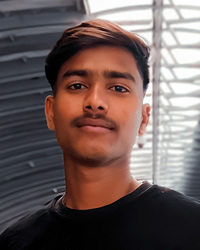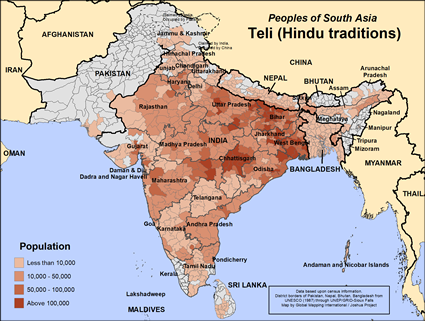Within the caste system there are numerous communities which have a given task to benefit others. The Teli community is one of these. Their name came from the Sanskrit word talika or taila, referring to oil extracted from sesame and mustard. Lord Shiva, a key Hindu god is central in their creation myth. Shiva created them to destroy five demons. However, their legend also says that the first Teli was created by Shiva to rub him with oil. Telis were traditionally considered one of the Vaisya, or trading communities. That put them as part of the third highest of four caste clusters.
Most Teli people live throughout India. A smaller number live in Bangladesh, Nepal, Sri Lanka or Pakistan.
The Teli community once did the labor-intensive job of pressing and extracting oil, but now that job is done by mechanical means. For this reason, they have mainly resorted to farming or animal husbandry. A good many of these are landless, and some have applied to be considered "Other backward castes" so they can receive special treatment from the Indian government. A smaller number of them are businessmen or hotel managers, metal workers, cart pullers, or common laborers. Many work in government jobs, and they are active in politics. The Teli people are endogamous, meaning that they only marry within their own community. Family heads and elders arrange their marriages, and they pay the dowry with cash and valuable goods. In today's world, Teli people live mainly in nuclear families. Like all other South Asian communities, women have lower status and power than men; however, women take a leading role in social and religious activities. Women also help with the family income through embroidery and other money-making activities.
The perception of Christianity as an invading influence that breaks up families and promotes many social problems is a serious obstacle to Teli families and communities humbly accepting God's blessing for their families.
The Teli are mainly Hindus who have special celebrations at weddings and the birth of a child. They cremate the dead, and scatter the ashes in a river, preferably the Ganges, a river that Hindus consider to be holy. They worship their ancestors and seek protection from evil spirits. This people group is pragmatic in their spiritual practices. They worship a "wish-fulfilling goddess" whom they hope will answer their prayers.
The Teli people are not usually poor, but they need better access to higher education and good job opportunities. They also need access to meeting the Risen Christ and the opportunity to follow him.
Pray that the Teli people in Nepal will develop a hunger for the true God. Pray that believers will reach out to this people with the blessings of Christ. Pray that soon the oil of the Holy Spirit would anoint Teli community leaders and lead them to throw open the doors for their people to follow Jesus. Pray for the Lord to raise up Teli believers who will disciple others and begin the process of starting a disciple making movement.
Scripture Prayers for the Teli (Hindu traditions) in Nepal.
| Profile Source: Joshua Project |













